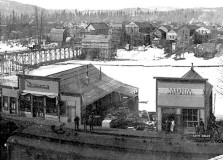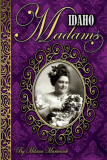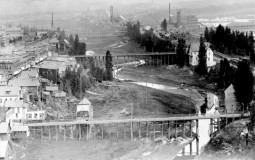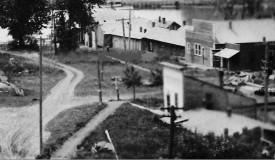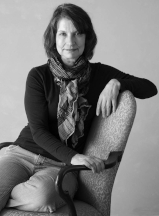No products in the cart.
Women of Love and Loss
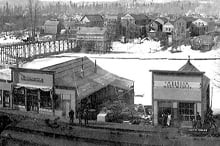
Old West Idaho Madams
By Milana Marsenich
After novelist and therapist Milana Marsenich was contracted to write the new nonfiction book, Idaho Madams, for Farcountry Press, she became fascinated by the infamous women she researched in Sandpoint, Lewiston, Boise, and in the mountain mining camps of Murray, Rocky Bar, Hailey, and Wallace.
The following edited excerpt from her introduction to the book, and her profile of Sandpoint madam Willa Herman, are reprinted with permission.
Writing a book about early frontier madams based on facts is quite different than writing a novel where I can invent events and stray from known details as the spirit carries me. Plus, this was not just writing a book based on facts, this was writing a book based on elusive, hidden, nearly nonexistent facts. The sex business in the Old West was secretive and shrouded in mystery. Most women did not leave behind diaries. People didn’t write articles or books about them. Many of the madams and prostitutes changed their names and used multiple aliases so as not to disgrace their families.
I read Heather Branstetter’s excellent book, Selling Sex in the Silver Valley: A Business Doing Pleasure [see “You Don’t Have to Obey the Laws,” IDAHO magazine, July 2017]. I called the Oasis Brothel Museum in Wallace, to attempt to get Jay Moynahan’s book The Sportin’ Women of Wallace and the Silver Valley,1888–1909. They didn’t have the book, but they had something better: his telephone number. I called and left a message. He called back and left a message saying that he was out of the country and would call when he returned. Jay has been researching and writing books about prostitution in early Idaho for more than twenty years. He was exceptionally generous with his information, his research, his books, and his suggestions of where and how to find information on the madams of Idaho….
East side of Sand Creek, Sandpoint, 1903. Courtesy Far Country Press.
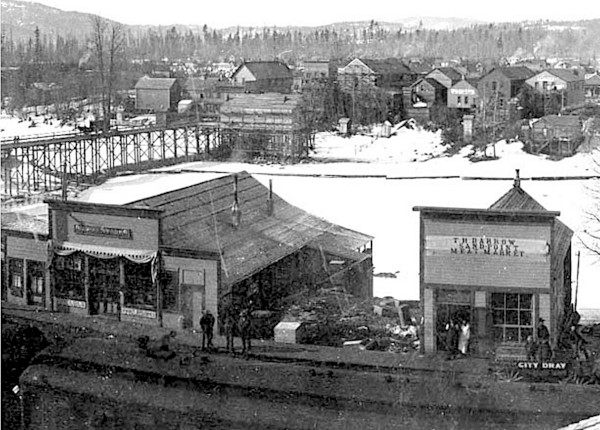
Cover of the new book. Courtesy Far Country Press.

Sandpoint, 1910. Courtesy Far Country Press.
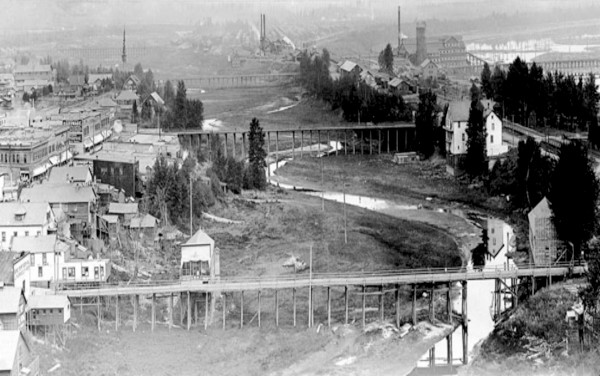
The dark building, second from right, was a brothel. Courtesy Far Country Press.
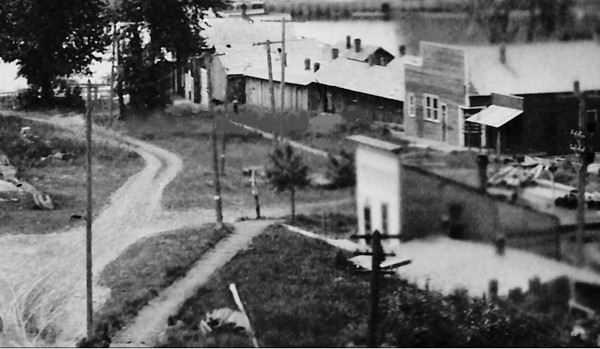
Almost everyone I talked to said, “Go to Wallace.” So, I did. I went to the Oasis Brothel Museum, the mining museum, and the library. The Wallace librarians were kind and enthusiastic about pulling out helpful resources. I walked around the town, looking at back doors to businesses and boarded-up windows. I climbed several staircases to see the old homes, and I stood at the corner of Bank and 6th Streets, the self-proclaimed “Center of the Universe.”
I also went to Murray. I crossed Thompson Pass, although not during a blizzard as Maggie Hall (aka Molly B’Damn) had done, and went to the Sprague Museum. The museum is dedicated to Molly B’Damn, who is revered in Idaho, and especially in Murray, as a kind and generous woman [see “Finding Mollie,” IDAHO magazine, November 2015]. I sat at the bar one morning and had a jalapeno cheeseburger for breakfast, listening to the bar owner and one of his early customers tell stories about Molly B’Damn Days, a yearly festival in Molly’s honor. I walked around the small mining town and up to the cemetery where Maggie Hall is buried. Her original tombstone, now old and weather-worn, has been replaced by a new one. Molly was your quintessential madam with a heart of gold, and the people of Murray now take care of her.
When I came to Lewiston, I read several of Steven Branting’s books and talked to Garry Bush, owner of Idaho History Tours. Both of these men know and understand Lewiston, its wild heart, and its history….Garry suggested I talk with Mary Romero, curator at the Nez Perce County Historical Society and Museum. Mary was especially helpful with research information and locating Lewiston photographs regarding the town and the madams who lived and worked there.
Idaho has a few well-known madams, such as Molly B’Damn, Peg Leg Annie, and Diamond Tooth Lil. I was able to find stories and anecdotes about these women and their personal lives. Many of the others have left behind nothing but bare census records and arrest reports. Yet they were all women trying to make it in the wild, rough, uncivilized West, women with stories held close to their hearts. Some looked for adventure, some took care of siblings, children, and husbands, and some simply tried to survive.
Many madams and prostitutes left homes that they could never return to. They had children and husbands. They had dreams. They wanted land, homes, stability, autonomy, and safety. They were women of courage and desperation, women of love and loss, women who bled when cut, like you and me.
Willa Herman
At the other end of the restricted district from the Riverside Saloon and Marie Henderson’s brothel [in Sandpoint], Willa Herman ran a bordello. She is listed in the 1910 census as twenty-eight years old, born around 1882. Willa told the census taker that she was the head of the household. Given the demographics of that household, and its location, even the most naïve census taker would’ve immediately understood the situation.
Three other women lived with Willa: Lillian M. Earl, twenty-five, from Canada; Nellie Archer, twenty-eight, from the United States; and Lulu Watson, twenty-eight, from Wisconsin. All three are listed as “roomers,”with, ahem, no occupation given. The household was rounded out by two men, both from Japan. Tsunata Watanabe, twenty-two, was a porter, and Charlie Aong, forty-two, was a dressmaker in the dance hall industry, a job that likely kept him busy.
The Owl Resort provided access to Willa’s house of ill repute. According to The Other Side of Sandpoint [the 2014 report of an Idaho Transportation Department archeological dig], her bordello was linked to the dance hall, with an upstairs parlor for entertaining customers. Typical of restricted district establishments, the Owl offered an array of vices and had a history of occasional unseemly incidents. In one instance, in February 1904, a jealous husband, Roy Murphy, from Tekoa, Washington, tracked down his erstwhile wife, who was going under the name Bonita Carlson, to her new place of employment at the Owl. After a few drinks and a little dancing, the couple retreated to her room upstairs. Then gunshots rang out. Marshal Harry Sawyer just happened to be at the Owl that night, and when he rushed upstairs, he found Murphy dead, his still-smoking gun in his hand. Bonita Carlson was lying in her own blood, two bullet wounds in her head and a third round lodged in her chest. Remarkably, she survived. And business at the Owl carried on as usual.
Willa Herman was born in Minnesota. What brought her west is unknown. She may have fallen in love and then suffered some misfortune. She may have been restless, with a yearning for adventure. She may have simply been part of the flood of men and women looking for a better life. Having brought style and finesse with her, she found her better life at the bordello next to the Owl.
Herman also went by the name Willow. Both names share a soft, graceful sound and suggest elegance and class. And if there is something in a name, her bordello lived up to it. Her business was small, slow, and refined. The three women who worked for her entertained customers at a leisurely pace, proffering drinks, fine foods, music, and lively, engaging conversation. They created an experience rather than a hurried exchange of services for money. A customer could linger for several hours, visiting in the parlor and dining at a well-appointed table before, ultimately, rendezvousing in the bedroom with a lovely woman.
Willa dressed well and coached her employees to do likewise. The women fixed their hair with elegant pins and combs. They wore makeup in the fashion of the day to enhance their beauty and guile. They wore stacked-heel shoes and lovely dresses, creating quite an impression for a man accustomed to the rough and tumble town of Sandpoint.
Willa also put considerable effort into making her bordello presentable. She tended to small, graceful touches, such as ornamental knickknacks, bric-a-brac, statues, and figurines. She had a tiny embossed stamp case, monogrammed “WH.” She kept it private, something just for her, something her customers probably never saw. The monogram demonstrated her attention to detail and a desire for something fine. Her dishes were colorful, designed for company.
She decorated the walls with pictures and placed small figurines on shelves and tables, demonstrating the Victorian sensibilities of the day. Even though she was ostracized from that middle class society, the decorations would have suited her customers, who likely came from among the merchants and professionals of the town.
Along with her flair for elegance, Willa also hinted at a playful, tongue-in-cheek humor in her décor. One figurine recovered during the archaeological dig was of a cupid figure. Another was part of the trio of monkeys, “See no evil, hear no evil, speak no evil,” making fun of the Victorian ideal.
But Willa’s charm couldn’t save her from happenstance and progress. The Owl Resort burned down in 1915. By 1916, the restricted district was out of business, as Sandpoint matured from rowdy logging camp into a proper town. Willa likely left Sandpoint for another town, another area, something that was wide open and profitable. She’d have brought her style, class, and elegance to the new town, taming the Wild West in her own way.
Idaho Madams is available at local bookstores and gift shops, through online retailers, or from Farcountry Press at 1.800.821.3874, www.farcountrypress.com
If you enjoyed this story, please consider supporting us with a SUBSCRIPTION to our print edition, delivered monthly to your doorstep.
This content is available for purchase. Please select from available options.
Purchase Only
Purchase Only

